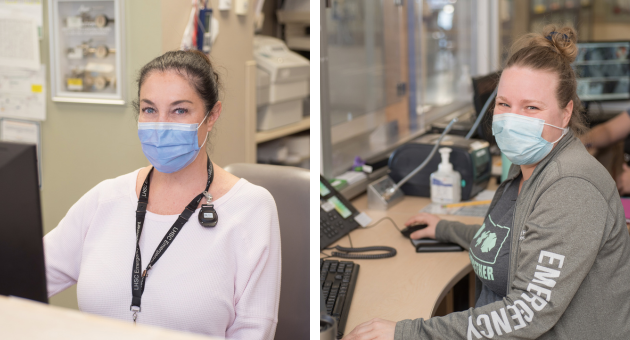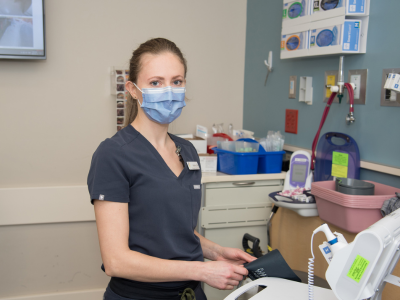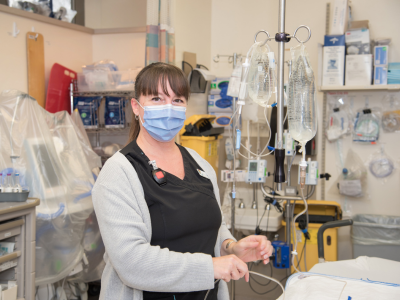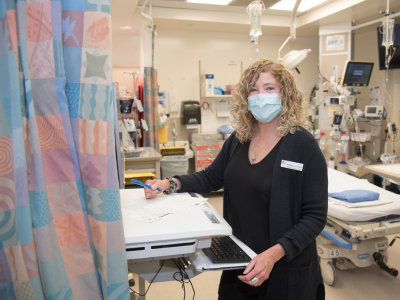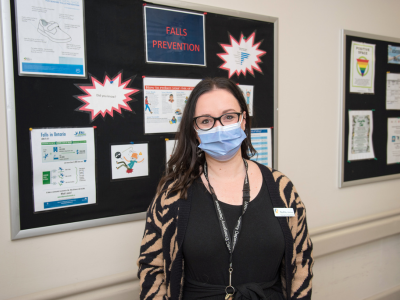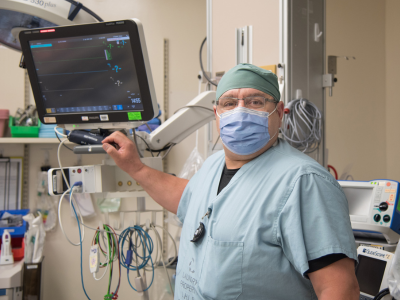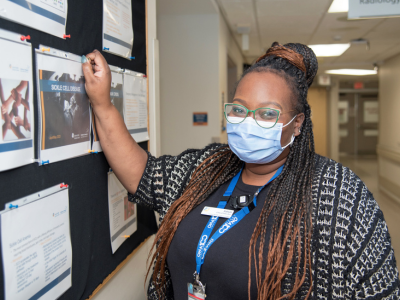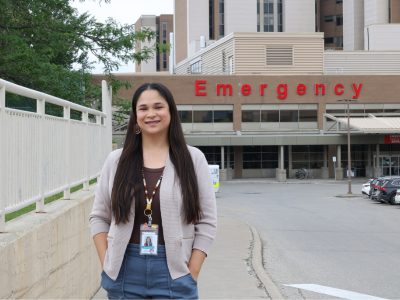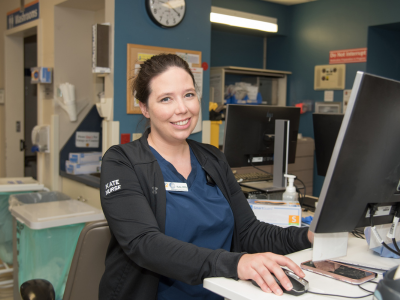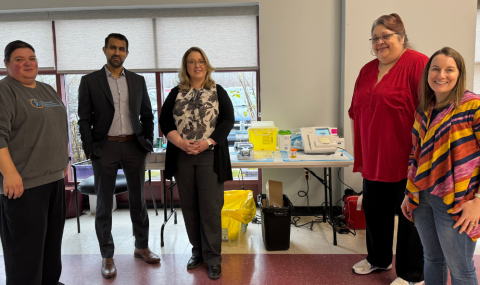The various roles in the Emergency Department
The adult Emergency Departments (ED) at University and Victoria hospitals at London Health Sciences Centre (LHSC) are diverse environments where a variety of professionals and professions work together to ensure those who enter our doors receive the care they need from the most appropriate individual.
There are some professions that every patient and caregiver will interact with during a visit, such as a unit clerk and triage nurse, and there are others that you may see walking the halls and wonder what their role is in patient care.
Read on to learn more about the different professionals you may encounter while in the ED.
Emergency Department Clerk
The Emergency Department clerk (ED clerk) role begins at registration. When you enter the ED, you are greeted by the clerk and your information is entered into the computer system. They will ask for your health card, demographic information (e.g., address, emergency contact, next of kin and primary care provider) and your reason for your visit.
In the ED, the clerks answer phones, arrange follow-ups, organize transportation (such as to a patient’s home, long-term care facilities and other hospitals). ED clerks also arrange diagnostic testing, process admissions to all services within the hospital and help navigate patients and family members through the department and the rest of the hospital, with discretion and compassion.
Communication between doctors, nurses, patients and clerks is a key part ED clerks play within LHSC’s adult EDs.
Triage Nurse
The triage nurse assesses each patient that comes to the ED, either from the emergency entrance or the ambulance bay.
They are responsible for prioritizing patients based on level of acuity – which they determine through a brief exam and taking your medical history.
Triage nurses continuously communicate with the nursing and physician team and help improve the flow of patients into and out of the ED by initiating some medical directives such as completing bloodwork, x-rays, and medication administration.
Charge Nurse
The charge nurse sets the tone for the entire department.
They do a lot within the ED that help keep it running as smoothly as possible. Some of what they do include, maintaining open communication with staff, deal with contraband and safety within the department and waiting room, they handle difficult conversations with patients, families and caregivers and guide through next steps, they follow-up on labs and speak with patients when they are discharged to ensure they are receiving the correct treatment and get the prescriptions they need if they’re already discharged from hospital. They also help provide information about available resources and services to those who have experienced sexual assault and assist with discharges to the home with Voyago, retirement homes or long-term care facilities.
Social Worker
There are three social workers that care for adult populations who present to the Emergency Departments at both University and Victoria hospitals at LHSC. Social workers within the EDs are flexible and adaptable to the needs of patients, and are knowledgeable in a variety of therapeutic interventions to provide the appropriate supports.
The ED is a critical intervention point for patients with multiple unmet medical, psychological, and social needs. ED social workers assist patients and their families in a variety of ways.
Social workers provide counseling to patients who pass through the ED and connect them with information and support, such as community resource linkage, and assist with discharge planning. They advocate for, and tackle social issues, within the hospital and with community partners, such as discrimination, oppression, domestic violence, human trafficking, poverty and grief/loss through a trauma-informed lens.
Social workers work together with patients and their families to help them identify their strengths so that they may become confident and self-reliant once discharged from the hospital.
Nurse Clinician (GEM nurse)
LHSC has two GEM (Geriatric Emergency Management) nurses. One GEM nurse is in the ED at University Hospital and the other is located at Victoria Hospital’s adult ED.
GEM nurses collaborate with the ED team to assess frail, at-risk seniors and link these patients to appropriate resources and specialized geriatric services in the community.
By having this support for seniors in the EDs, GEM nurses help reduce hospitalizations, minimize repeat ED visits, help maintain functional abilities and connect them with proper community supports to get them home safely, and provide intervention and prevention strategies that will help seniors maintain their level of independence and well-being.
Most GEM Nurses by necessity are skilled ED Registered Nurses (RNs) with advanced clinical training in geriatric syndromes including mental health, atypical disease/symptom pattern, and frailty along with its impact on health status, wellness, end of life trajectory. LHSC’s GEM nurses are two of the more than 130 GEM nurses across Ontario. GEM nurses are one piece of a regional network (Regional Geriatric Programs of Ontario) of health care professionals.
GEM nurses focus on clinical consultation with patients and ED staff, and education for patients and families.
Emergency Department Technician (EDT)
The Emergency Department Technician (EDT) has a wide scope of practice that includes assisting physicians and nurses with patient flow and care, maintaining equipment in the ED and ensuring stock availability of items needed.
EDTs also help with patient transfers to all corresponding tests and transfers all critical patients to the inpatient floors. They assist physicians with resuscitation measures (including CPR) and with medical procedures (such as suturing and central line insertions) as needed.
EDTs work with the physicians and nurses assisting with cardio-versions (a procedure done to put a patient’s heart into regular rhythm) and other medical procedures, as well with reductions and orthopaedic applications (e.g., air boots applications, splints, crutches, slings, and cervical collars).
Emergency Department (ED) Clinical Educator
The clinical educator role has recently expanded to include two educators at each emergency department site. All four educators work collaboratively citywide to educate, train and promote the emergency standards set by LHSC and national accreditation boards.
The clinical educators, all with previous emergency nursing experience, promote excellence within the Emergency Department through coaching and mentoring of the staff. They provide leadership and clinical expertise to support quality excellence in patient care by planning, developing, implementing and evaluating programs that enhance clinical proficiency, quality improvement and team development.
The clinical educators play an important role in ensuring that the Emergency Department staff are supported and competent in the provision of patient care at LHSC.
Indigenous Navigator
LHSC has two Indigenous Navigators in our Emergency Departments – one is located at University Hospital and the other is located at Victoria Hospital’s adult ED. The Indigenous Navigator improves quality care by providing supports for the client’s physical, social, emotional and spiritual needs. The Navigator also advocates for Indigenous patients, caregivers and their families and assist in bridging the service gaps between Indigenous communities and healthcare providers.
The Indigenous Navigator has a variety of responsibilities, and include: coordinating client/family spiritual care requests or access to sacred spaces within the hospital to support Indigenous beliefs and practices; support patients in communicating with physicians, nurses and other frontline staff; coordinate, as required, client referrals to and from interagency, Indigenous communities, Indigenous organizations and other health care programs and services; help navigate the Non-Insured Health Benefits (NIHB) program; and, most importantly, be someone who Indigenous patients can relate to, trust, feel safe with and know that someone is listening.
The Navigator’s goal is to assist patients through the healthcare system in a culturally safe and relevant manner, and also act as a resource to staff to help foster a safe and inclusive space.
Registered Practical Nurse
Within the ED, Registered Practical Nurses (RPN) have a unique role and experience. They work with mental health and medical patients, often with those population groups overlapping. The medical population ranges from Medical Acute Care of the Elderly (MACE) to Trauma patients.
RPNs in the ED are unique – from initial assessments to medication administration to nursing skills, RPNs are able to do support patients in a number of ways. RPNs liaise with patients from those requiring social supports for a safe discharge to more complex patients that require hospital admission. They work collaboratively on a large, interdisciplinary team within the ED that includes physicians, residents, nurses, technicians, PSWs, clerks, social workers, addiction counsellors, Indigenous liaisons, and community partners.
The outcome is for patient safety and optimized recovery whether it be as an admitted patient or discharged home. RPNs work with a patient centered focus. They optimize recovery, ensure patient safety, and continuously engage with ongoing patient education that enables choices for patients within the department and at home.
Medical Lab Assistant
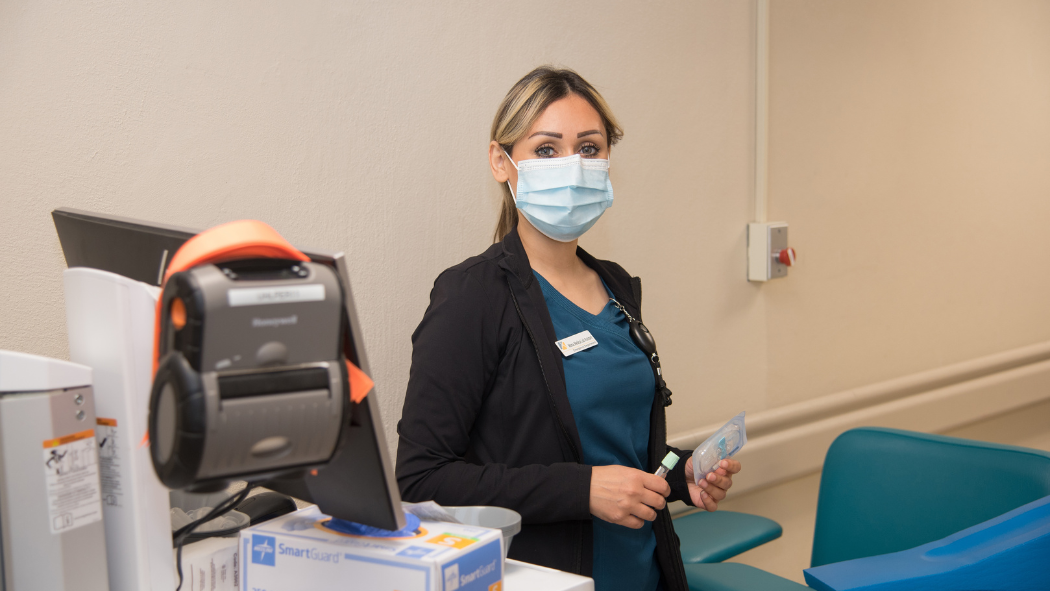
The Medical Lab Assistant in the Emergency Department (ED) supports both University and Victoria hospitals and plays a crucial role in providing timely and accurate diagnostic support to care teams. Their responsibilities help facilitate efficient patient care and diagnostics in the fast-paced environment of the ED. Medical Lab Assistants in the ED have excellent communication skills, attention to detail, adaptability and the ability to work efficiently under pressure. Their contributions are integral in delivering swift and accurate diagnostic information that supports effective patient care in critical situations.
Key duties of a Medical Lab Assistant in the ED include:
- Collecting specimens, such as blood, from patients for diagnostic testing.
- Collaborating with healthcare professionals, nurses, and physicians daily to support patient care.
- Strictly following safety protocols and infection control measures to ensure a safe working environment for both patients and staff.
- Monitoring and managing supplies, reagents, and equipment to ensure an adequate stock for continuous operations.
- Keeping up-to-date with advancements in laboratory technology, techniques, and protocols through continuous education and training opportunities.
Centralized Emergency Psychiatric Services (CEPS) (Victoria Hospital)
The Centralized Emergency Psychiatric Services (CEPS) provides emergency assessment and treatment for adults who present at the Victoria Hospital (VH) Emergency Department (ED) with mental health and substance use issues.
The CEPS service consists of registered nurses, social workers, an addiction counselor, psychiatry consults and psychiatry residents and provides psychiatric consultation and care for those awaiting an inpatient bed. The CEPS team works collaboratively with other ED staff and physicians to achieve patient-centred care.
There is a nurse screener role that is available 24/7 in the VH ED and a primary nursing role available for admitted patients. An addictions counselor is available Monday – Friday, and a social worker is in the ED seven days a week.
Dementia Resource Consultant (University Hospital)
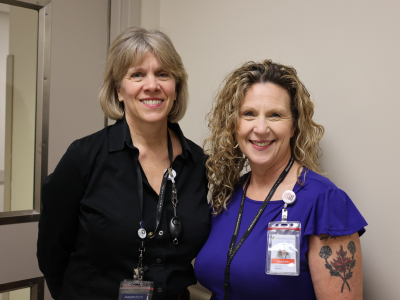
The Dementia Resource Consultant in the University Hospital Emergency Department (UH ED) assists in supporting and de-escalating people living with dementia during their emergency visit, by offering various resources (iPads, music, baby dolls, puzzles, etc.). Using best practice guidelines, they model a unique approach in communicating with clients, while also spending time with families to fully understand their journey and explore the potential for in-home supports. This consultant can assist in making referrals to community resources within London Middlesex and the Local Health Integration Networks (LHIN) to ensure clients and their families are followed and supported both during a crisis but also on an ongoing basis.
This newly introduced role is made possible through a partnership with the Alzheimer Society to address gaps in community dementia care in the Southwest region.
